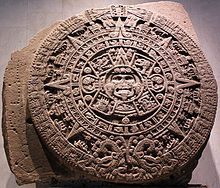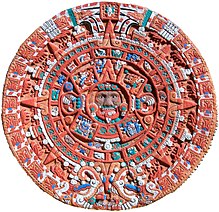Stone of the sun
The Stone of the Sun or Sunstone ( Spanish Piedra del Sol ), often erroneously called the Aztec calendar stone , is a large monolithic sculpture from the area of the old main temple of Tenochtitlán ( Mexico City ).
The basalt sculpture measures approximately 3.6 meters in diameter and 1.22 meters thick. The weight is 24 tons. The stone was discovered during leveling work on December 17, 1790 in the square south of the cathedral and, by order of the viceroy, was attached to the foot of the west tower of the cathedral. The stone was popularly called Reloj de Montezuma (Montezuma's clock) , probably because of its position on the church tower . It has been in the National Museum of Anthropology and History since 1885 and occupies the central position of the Aztec Hall in its new building in Chapultepec Park in Mexico.
Subject and content
The stone sculpture shows a structure in concentric rings around the central face of the sun god Tonatiuh, which was intentionally mutilated in ancient times . According to another opinion, the center shows the earth goddess Tlaltecutli . The tongue, which has the shape and decoration of a sacrificial knife, is stuck out far down from the face. Large discs of earrings can be seen on both sides of the mouth. The face is inserted in the center of the four-branch day symbol olin (movement). There are four large disks on either side, which together form the number 4 , i.e. the date of the day 4 Movement, which stands for the current world age:
- Earthquake sun ( Nahuatl : nāhui olin )
In the branches of the olin symbol are the hieroglyphic symbols for the four "suns" or world ages, which, according to the Aztecs, preceded the present and were named after the day on which they ended in a catastrophe. They are (from the top right counterclockwise):
- Jaguar sun with the current date 4 Jaguar (Nahuatl: nāhui ōcēlōtl )
- Wind sun with the date 4 wind (Nahuatl: nāhui e'ēcatl )
- Rain sun with the day date 4 rain (Nahuatl: nāhui quiyahuitl )
- Water sun with the date 4 water (Nahuatl: nāhui ātl )
To the left of the point rising above the face of the sun god is a small representation of a xiuhuitzolli , the headdress that characterizes a ruler, and other pieces of jewelry. To the right of the tip is the date of the day 1 flint knife ( cē tecpatl ), which is assigned the north direction. Below the face there are two daily dates: on the left 1 rain ( cē quiyahuitl ) with the face of the rain god Tlaloc, easily recognizable by the teeth, and on the right 7 monkeys ( chicōme ozoma'tli ), each of which is seen in connection with the West.
The next ring consists of the twenty day signs , beginning at the top with the day sign caiman ( cipactli ) and running counterclockwise. It is only this ring that in a certain sense justifies the name “calendar stone”.
The following ring is the widest. The clearest structure consists of eight outwardly directed points, which express the rays of the sun and thus indicate that the actual solar disk is closed with the next inner ring. Between the rays of the sun there is a ring with four by ten squares, which are supposed to express precious pieces of jewelry (the assumption that the squares with their five elements represent a five-day week does not lead to any further, as there is nowhere occupied cycle of 200 days would result). All other symbolic signs in this ring represent precious pieces of jewelry made of jade or feathers.
The outermost ring is formed by two mythical snake creatures emanating from above, whose heads and open jaws can be seen in the lowest part of the ring. The bodies of the snakes are divided into eleven square sections, which are formed by flame symbols. Flames also beat from the back of the bodies into the space of the ring further inside. The heads of the two snakes show a wide open mouth, the large teeth are clearly visible. The faces of two gods peer out of the mouth: on the left it is the fire god Xiuhtecuhtli , who is identified by the face painting expressed here by hatching, and on the right again Tonatiuh. As in the central depiction, the flint knife-shaped tongue hangs out wide on both of them. The year 13 cane (Matlactli omey Acatl) is shown in a rectangular frame between the tail tips of the snakes.
On the outside of the disc there is a narrow border with depictions of the Venus symbol and sacrificial knives.
function
The function of the stone has been debated since it was found. If the stone was fixed horizontally on or in the vicinity of the Templo Mayor , it could have been a Cuauhxicalli on which offerings were placed. Another interpretation sees a Temalacatl in the stone , on which the victim was tied with a rope and was only allowed to defend himself against a fully armed warrior with dummy weapons . The assumption, inspired by the representation of the Teocalli de la Guerra Sagrada , that the stone had been erected vertically on a temple facade, is no longer supported.
See also
literature
- Peter J. Schmidt: The sun stone of the Aztecs . Museum of Ethnology, Hamburg. no year
- Felipe Solís: La Piedra del Sol . In: Arqueología Mexicana 41 (2000) pp. 32-39
Web links
Individual evidence
- ↑ Ulrich Köhler: vassals of the left-handed warrior in the hummingbird robe; Ethnological Studies Vol. 39

